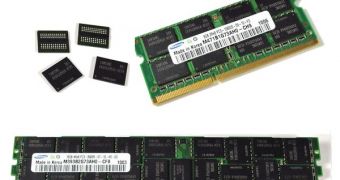In some parts of the world, the economic recession has started to go away, leading to significant boosts in demand for all sorts of IT products. In others, such as Europe, the crisis is actually still in play, and quite strong. This created a sensitive situation where makers of any type of hardware have to carefully consider their pricing plans and how they balance out their investments and shipments. In the case of DRAM products, the result seems to have been an actual drop in overall prices.
For suppliers of DRAM devices, a drop in pricing isn't exactly the most fortuitous outcome, but consumers will most likely be pleased to know that they will have the chance to spend less on their new memory upgrade. During the first half of the ongoing month, DRAM chips became less expensive, enabling 2GB DDR3 modules to sell for roughly US$44, or 2-4% less than before. At least, this is what a recent report made by Digitimes claims.
This is just the tip of the iceberg, however. The same report actually states that some module and IC distributors ship the same part for US$40 or even as low as US$37-38. Not only that, but prices will supposedly keep falling during the second half of 2010, because DRAM makers using more advanced processes will increase their capacities. Powerchip Technology, for one, migrated to 63nm and intends to move on to 45nm technologies by the end of the year. Meanwhile, Hynix Semiconductor and Samsung Electronics are migrating to the 40nm process.
These three aren't the only players with big plans; however, Nanya Technology, Inotera Memories and Micron Technology have already started to make more 50nm chips at their respective facilities. As for DDR2, makers will supposedly decrease output, which means that pricing should remain constant throughout the following two quarters.

 14 DAY TRIAL //
14 DAY TRIAL //